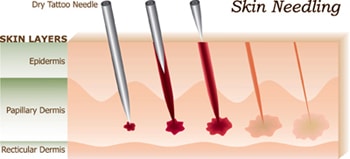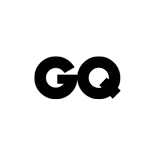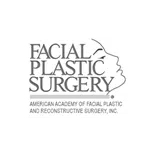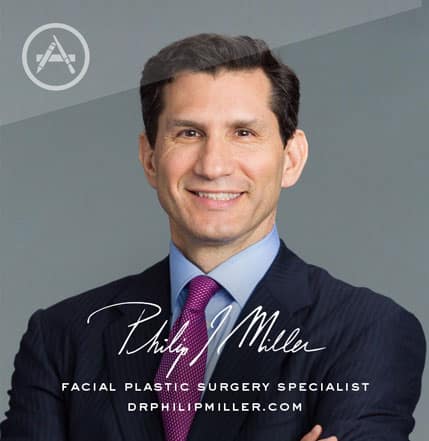Wrinkle and Scar Revision
Types of Wrinkle and Scar Treatments
People of all ages want to smooth fine lines, wrinkles, and acne scars. This can be achieved by “resurfacing” techniques that peel, exfoliate, and rejuvenate skin. Methods include chemical peels, dermabrasion, and laser treatments. These procedures remove the top layer of skin (epidermis) to stimulate re-growth. As new skin develops, collagen and elastin are produced which helps smooth and tighten the skin. Although resurfacing is effective, the skin damage can create side effects including whitening or color loss (hypo-pigmentation), darkening (hyperpigmentation), overall thinning, or sun sensitivity. Also, the areas around the eyes must be avoided with these procedures. Because some people are not good candidates for these skin resurfacing techniques, an alternative method is offer at Gotham Plastic Surgery in New York City called “Needling” or “Skin Needling.”
Read More
What is Skin Needling?
Skin Needling is also called “Facial Needling” or “Microneedling” (it is not Acupuncture). The technique reduces the depth of wrinkles and fine lines on the face. It also reduces shallow depressed scars such as Chicken Pox or acne scars. Facial needling is a natural skin rejuvenation method that fills and softens wrinkles and scars. It does not use chemicals, fillers, injections, or lasers. The process creates hundreds of microscopic “pinpricks” to activate your body’s wound healing process. As your skin heals, it uses your own collagen to fill the “valleys” of wrinkles and scars naturally. The technique was discovered to be effective in the 1940’s, but the methods of performing it today are more sophisticated.
Needling is also called Dry Needling, Dry Tattooing, Needle Abrasion, Needle Dermabrasion, Facial Mesotherapy, Multitrepannic Collagen Actuation (MCA), Percutaneous Collagen Induction (PCI), or Collagen Induction Therapy (CIT). This procedure is more popular in other countries than in the United States. However, plastic surgeons in the U.S. have used it in addition to those in Europe, Canada, Australia, New Zealand, and South Africa.
How Does Skin Needling Work?

Applications of the Needling Technique:
- Wrinkle Treatment: Fine lines and wrinkles on the face can be diminished with facial needling.
- Indented Scars: Needling procedures can decrease the depth of pitted, depressed, or shallow scars caused by acne, chicken pox, surgeries, or trauma.
- Surgical Scars: Raised or hypertrophic (overgrown) scars can become smoother with needling treatments that flatten the elevated scar tissue. Examples include borders of skin grafts and other hypertrophic surgical scars.
- Scar Relaxation: Burns and accidents can create fibrous bands of scar tissue that often contract and limit movement. Needling can break down the contracted scar tissue to increase mobility and flexibility. This process is referred to as Scar Tissue Relaxation or Relaxation of Scar Tissue.
What are the Benefits of Needling?
Results are similar to those from other skin resurfacing methods. However, the needling technique has several advantages:
Epidermis Remains Intact: Needling does not remove or damage the outer skin layer (epidermis) entirely like other resurfacing methods do. The healthy skin and blood vessels in-between the lines, wrinkles, or scars is preserved. That improves healing, collagen production, and long-term results.
Fewer Pigmentation Changes: Because the epidermis is left untouched, there is less risk of permanent structural damage such as post-inflammatory hyperpigmentation (skin darkening) or de-pigmentation (color loss or skin whitening).
Fewer Side Effects: There are no side effects such as thinning of the skin or increased sun sensitivity because the epidermis is preserved. Skin needling uses no artificial fillers so the chance of an allergic reaction or infection is also minimized.
Fast Healing and Downtime: Needling is precisely controlled and creates minimal dermal trauma. Healing is rapid with a short “downtime” of only a few days.
Ongoing Treatments are Possible: Other resurfacing methods cannot be repeated indefinitely because they eventually thin the skin and create photosensitivity. But needling can be repeated safely because the dermis becomes thicker in the treated areas instead of thinner. Also, other resurfacing methods must avoid the delicate eye area, but needling can safely treat areas around the eyes such as “Crow’s Feet.” It can also be performed safely on skin that previously had laser re-surfacing treatments or dermabrasion.
How is the Procedure Performed?
Your aesthetic specialist performs needling using digital tattoo equipment and safety needles—but they will not inject anything into your body and will not implant any color pigments. This procedure is “dry needling,” so it is also referred to as a dry tattoo or dry tattooing. The specialist first applies a topical anesthetic to numb the treatment area so the procedure will not be painful. They then insert a sterile needle 1 to 2 millimeters into the skin (epidermis and top layer of the dermis) to create shallow puncture wounds. They guide the needle to make multiple insertions within the borders of a line, wrinkle, or scar. The dry needling causes pinpoint bleeding that is minimal and stops quickly. Your body’s natural healing process is activated at that point and the rest is up to your own collagen production.
How Long is the Healing Process?
For either wrinkle or scar treatments, swelling is minimal and surface (outer) healing occurs in a few days. Immediately after a procedure, your skin will look red in the places that were needled. Fine lines and wrinkles will look like “cat scratches” or appear like they have “paper cuts” inside them. Scars will be red as if a scab had just been peeled off. A light scab will form on the treated areas (it is common for light scabbing to occur with skin penetration procedures). Redness lasts 3 to 4 days then turns pink by day 4 or 5 and continues to fade. During the first 3 to 7 days, ointments should be applied to the broken skin. Procedures should be performed a minimum of 6 to 8 weeks apart to allow for complete healing and collagen production. Learn more about skin needling, visit ncbi.gov.
Results and Number of Treatments
The number of required treatment sessions varies according to the depth of each wrinkle or scar. Improvement in the needled areas may be seen as soon as a few weeks after a procedure. However, inner healing of the skin continues for several months. During this time the needled skin will smooth and tighten as collagen is deposited.
Fine lines or wrinkles may need 1 to 2 sessions to be plumped. Medium to deeper wrinkles and acne scars may require 3 or more treatments for optimal results. Pitted scars and deep wrinkles may require 4 to 6 sessions or more for optimum depth improvement. Results can be enhanced and maintained when special vitamin creams are used after initial healing. Needling can also be combined with other treatments including Botox, IPL, and traditional surgical procedures.
To learn more about procedure, or to schedule a consultation with our medspa team, please contact Gotham Plastic Surgery at New York City or fill out our online consultation form.
Plastic Surgery from Head to Toe
At Gotham Plastic Surgery, we create custom treatment plans that combine minimally-invasive techniques and advanced technology to help patients achieve the best version of themselves. Our unique NatraFace™ approach addresses both restorative and transformative changes.
Gotham’s expert physicians perform advanced surgical and non-surgical procedures that smooth the skin around the eyes to give patients a refreshed look. Our custom NatraEye™ technique combines the use of chemical peels, lasers, eyelash enhancement, and injectables with precision procedures, including:
Our esteemed surgeons utilize the NatraNose™ technique to bring together innovative artistry and unparalleled skill to deliver results that look natural, improve nasal function, and help achieve each patient’s aesthetic goals.
Regardless of your aesthetic goals, Gotham has the skill and technique required for the breast procedure that suits you. Whether adding symmetry or restoring the breast following a mastectomy, Gotham provides patients with enhanced feminine contours and improved body proportions.
Patients from all over the world have undergone amazing body transformation at Gotham, enjoying slimmer bodies with satisfying contours. Our advanced physicians apply their skill and expert technique to precisely sculpt other areas of the body, including the cheeks, chin, buttocks, hips, love handles, knees, upper arms, thighs, and even the neck.
- Tummy Tuck (Abdominoplasty)
- Revision Tummy Tuck
- Liposuction (Lipoplasty or Lipectomy)
- Body Banking
Known for our flawless techniques and a range of skincare options, Gotham Plastic Surgery has all the tools necessary for complete, natural, and comprehensive rejuvenation. As part of a customized treatment plan, these procedures can be performed standalone or in combination with surgical procedures for even more impressive results.
- Dermal Fillers: Juvéderm®, Restylane
- Volume Restoration: Voluma®, BodyBanking®
- Neuromodulators: Botox®, Dysport®, Xeomin®
- Laser Procedures
- CoolSculpting®
- Ultherapy
- Scar Reduction
The male face ages differently than the female face, but men have similar goals of wanting to maintain their youthful appearance throughout their lives. A plastic surgeon must take the subtle differences between male and female skin, as well as what comprises the ideal look for their male patients.
No matter what your specific cosmetic concerns might be, Dr. Miller can help. At Gotham Plastic Surgery, we frequently perform the following for our male patients:
Trust the Experts














The Plastic Surgery Podcast with Dr. Philip Miller
Tune into The Plastic Surgery Podcast, hosted by facial plastic surgeon Dr. Philip Miller. Dr. Miller is here to answer your questions, de-mystify plastic surgery, and help you feel more knowledgeable and empowered about any procedure performed at our center.
-


Episode 44: My First Time
8 min -


Episode 43: Top 10 Reasons Not To Get A Rhinoplasty ( Plastic Surgery)
20 min -


Episode 42 : Osteomas & Lipomas
11 min -


Episode 41: All Ears Considered!
8 min -


Episode 40: Infrared Light Therapy
9 min -


Episode 39: Beauty, the Plateau
6 min -


Episode 38: Botox and Dermal Fillers
3 min -


Episode 37: Cost of Rhinoplasty
1 min -


Episode 36: Different Types of Nasal Surgeries
3 min -


Episode 35: Do You Have to Break the Nose for Rhinoplasty?
2 min -


Episode 34: Do You Have to Stay Overnight After Having a Rhinoplasty?
2 min -


Episode 33: Don't Have a Rhinoplasty!
2 min -


Episode 32: Endonasal or External
1 min -


Episode 31: Are You a Candidate?
2 min -


Episode 31: Asian Nose Job
3 min -


Episode 30: In The Office
17 min -


Episode 29: Can My Nose be Made Smaller?
4 min -


Episode 28: Can't Breath Through Nose
3 min -


Episode 27: Chin Implants - Mentoplasty
2 min -


Episode 26: Columellar Struts
23 sec -


Episode 25: Common Terms
5 min -


Episode 24: Connection Between Facial Resurfacing and Tattooing
5 min -


Episode 23: The Sooner, The Better?
4 min

Plastic Surgery w/ Dr. Miller
If you’re thinking about getting a lift, nip, or tuck, this app is for you. It’s the most comprehensive pocket encyclopedia of plastic surgery terms, before and after photos, and visualization tools to help you really know what to expect from a procedure, including seeing potential results on your own photo. This app is only available on the App Store for iOS devices.
View in App Store >



